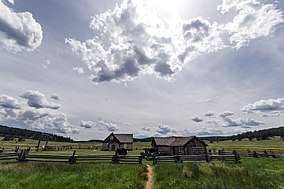| Florissant Formation | |
|---|---|
| Stratigraphic range: Late Eocene, | |
 Florissant Formation at the Clare fossil quarry in Florissant, Colorado | |
| Type | Formation |
| Overlies | Wall Mountain Tuff, Pikes Peak Granite |
| Thickness | 74 m (243 ft) |
| Lithology | |
| Primary | Shale |
| Location | |
| Coordinates | 38°54′50″N 105°17′13″W / 38.914°N 105.287°W |
| Region | Colorado |
| Country | |
| Type section | |
| Named for | Florissant, Colorado |
| Named by | Cross |
| Year defined | 1894 |
| Florissant Fossil Beds National Monument | |
|---|---|
IUCN category V (protected landscape/seascape) | |
 The Pioneer House, showing how the original pioneers of the west lived | |
| Location | Teller County, Colorado, United States |
| Nearest city | Florissant, Colorado |
| Coordinates | 38°54′49″N 105°17′11″W / 38.91374°N 105.28627°W[1] |
| Area | 5,998 acres (24.27 km2)[2] |
| Authorized | August 20, 1969 |
| Visitors | 71,763 (in 2017)[3] |
| Governing body | National Park Service |
| Website | Florissant Fossil Beds National Monument |
The Florissant Formation is a sedimentary geologic formation outcropping around Florissant, Teller County, Colorado. The formation is noted for the abundant and exceptionally preserved insect and plant fossils that are found in the mudstones and shales. Based on argon radiometric dating, the formation is Eocene (approximately 34 million years old [4]) in age and has been interpreted as a lake environment. The fossils have been preserved because of the interaction of the volcanic ash from the nearby Thirtynine Mile volcanic field with diatoms in the lake, causing a diatom bloom. As the diatoms fell to the bottom of the lake, any plants or animals that had recently died were preserved by the diatom falls. Fine layers of clays and muds interspersed with layers of ash form "paper shales" holding beautifully-preserved[5] fossils. The Florissant Fossil Beds National Monument is a national monument established to preserve and study the geology and history of the area.
- ^ "Florissant Fossil Beds National Monument". Geographic Names Information System. United States Geological Survey, United States Department of the Interior. Retrieved August 8, 2012.
- ^ "Listing of acreage – December 31, 2011" (XLSX). Land Resource Division, National Park Service. Retrieved 2012-05-13. (National Park Service Acreage Reports)
- ^ "NPS Annual Recreation Visits Report". National Park Service. Retrieved 2018-04-09.
- ^ McIntosh, W. C.; Geissman, J. W.; Chapin, C. E.; Kunk, M. J.; Henry, C. D. (1 May 1992). "Calibration of the latest Eocene-Oligocene geomagnetic polarity time scale using 40Ar/39Ar dated ignimbrites". Geology. 20 (5): 459–463. doi:10.1130/0091-7613(1992)020<0459:COTLEO>2.3.CO;2.
- ^ Erwin, Diane M.; Looy, Cindy. "Florissant Fossil Beds National Monument, Colorado". UCMP Berkeley. Retrieved 29 June 2015.



